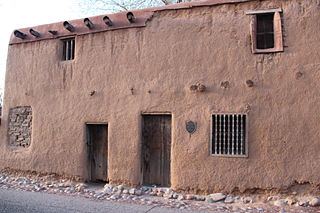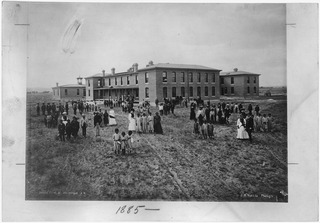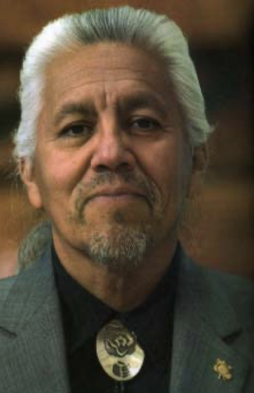Related Research Articles

Santa Fe de Nuevo México was a province of the Spanish Empire and New Spain, and later a territory of independent Mexico. The first capital was San Juan de los Caballeros from 1598 until 1610, and from 1610 onward the capital was La Villa Real de la Santa Fe de San Francisco de Asís.
The Pueblo Revolt of 1680, also known as Popé's Rebellion or Po'pay's Rebellion, was an uprising of most of the indigenous Pueblo people against the Spanish colonizers in the province of Santa Fe de Nuevo México, larger than present-day New Mexico. Incidents of brutality and cruelty, coupled with persistent Spanish policies that stoked animosity, gave rise to the eventual Revolt of 1680. The persecution and mistreatment of Pueblo people who adhered to traditional religious practices was the most despised of these. The Spaniards were resolved to abolish "pagan" forms of worship and replace them with Christianity. The Pueblo Revolt killed 400 Spaniards and drove the remaining 2,000 settlers out of the province. The Spaniards returned to New Mexico twelve years later.

Pecos National Historical Park is a United States National Historical Park in San Miguel County, New Mexico. The park, operated by the National Park Service, encompasses thousands of acres of landscape infused with historical elements from prehistoric archaeological ruins to 19th-century ranches, to a battlefield of the American Civil War. Its largest single feature is Pecos Pueblo also known as Cicuye Pueblo, a Native American community abandoned in historic times. First a state monument in 1935, it was made Pecos National Monument in 1965, and greatly enlarged and renamed in 1990. Two sites within the park, the pueblo and the Glorieta Pass Battlefield, are National Historic Landmarks.

The KiMo Theatre is a theatre and historic landmark located in Albuquerque, New Mexico on the northeast corner of Central Avenue and Fifth Street. It was built in 1927 in the extravagant Pueblo Deco architecture, which is a blend of adobe-style Pueblo Revival architecture building styles, decorative motifs from indigenous cultures, and the soaring lines and linear repetition found in American Art Deco architecture.

The De Vargas Street House, often referred to as the Oldest House, is a historic building in Santa Fe, New Mexico, which is often said to be one of the oldest buildings in United States. The original date of construction is unknown but the majority of the building is believed to date to the Spanish colonial period (post-1610). One archaeological study also concluded that some sections of the walls are characteristic of Pueblo architecture and may be pre-Spanish in origin. The building was listed on the National Register of Historic Places and New Mexico State Register of Cultural Properties in 1968 as a contributing property in the Barrio De Analco Historic District.

The Cathedral Basilica of Saint Francis of Assisi, commonly known as Saint Francis Cathedral, is a Roman Catholic cathedral in downtown Santa Fe, New Mexico. It is the mother church of the Archdiocese of Santa Fe.

The historic U.S. Route 66 ran east–west across the central part of the state of New Mexico, along the path now taken by Interstate 40 (I-40). However, until 1937, it took a longer route via Los Lunas, Albuquerque, and Santa Fe, now roughly New Mexico State Road 6 (NM 6), I-25, and US 84. Large portions of the old road parallel to I-40 have been designated NM 117, NM 118, NM 122, NM 124, NM 333, three separate loops of I-40 Business, and state-maintained frontage roads.
The history of New Mexico is based on archaeological evidence, attesting to the varying cultures of humans occupying the area of New Mexico since approximately 9200 BCE, and written records. The earliest peoples had migrated from northern areas of North America after leaving Siberia via the Bering Land Bridge. Artifacts and architecture demonstrate ancient complex cultures in this region.

The Pueblo Revival style or Santa Fe style is a regional architectural style of the Southwestern United States, which draws its inspiration from Santa Fe de Nuevo México's traditional Pueblo architecture, the Spanish missions, and Territorial Style. The style developed at the beginning of the 20th century and reached its greatest popularity in the 1920s and 1930s, though it is still commonly used for new buildings. Pueblo style architecture is most prevalent in the state of New Mexico; it is often blended with Territorial Revival architecture.

The Albuquerque–Santa Fe–Los Alamos combined statistical area is made up of eight counties in north central New Mexico. The combined statistical area consists of the Albuquerque and Santa Fe metropolitan statistical areas, and the Las Vegas, Los Alamos, and Española micropolitan statistical areas. The 2013 delineations included the Grants micropolitan statistical area, but it was removed in the 2018 revisions. As of the 2020 census, the CSA had a population of 1,162,523. Roughly 56% of New Mexico's residents live in this area. Prior to the 2013 redefinitions, the CSA consisted only of the Santa Fe metropolitan statistical area and the Española micropolitan statistical area. The total land area of the Albuquerque–Santa Fe–Las Vegas combined statistical area in the 2013 definition is 26,421 sq mi (68,430 km2).

Santa Fe is the capital of the U.S. state of New Mexico. With a population of 87,505 at the 2020 census, it is the fourth-most populous city in the state. It is also the county seat of Santa Fe County. Its metropolitan area is part of the Albuquerque–Santa Fe–Los Alamos combined statistical area, which had a population of 1,162,523 in 2020. Human settlement dates back thousands of years in the region. The city was founded in 1610 as the capital of Nuevo México, replacing previous capitals at San Juan de los Caballeros and San Gabriel de Yunque; this makes it the oldest state capital in the United States.
The following is a timeline of the history of the city of Albuquerque, New Mexico, US.
Marjorie Bear Don't Walk is an Ojibwa-Salish health care professional and Native American fashion designer. She is most known as an advocate for reforms in the Indian Health Service, and specifically the care of urban Native Americans. In addition, she is a fashion designer who has targeted career women, designing professional attire which incorporated traditional techniques into her clothing.
Miguel H. Trujillo (1904–1989) was an American activist from Isleta Pueblo, who was instrumental to the case Trujillo v. Garley in 1948; before the case, New Mexico, like many other states, had a ruling that "Indians not taxed" were not legally allowed to vote. With the case Miguel successfully challenged this ruling.

Kate Peck Kent, born Kate Stott Peck, was an American anthropologist who studied the history of Pueblo and Navajo textiles.

Albuquerque Indian School (AIS) was a Native American boarding school in Albuquerque, New Mexico, which operated from 1881 to 1981. It was one of the oldest and largest off-reservation boarding schools in the United States. For most of its history it was run by the Bureau of Indian Affairs (BIA). Like other government boarding schools, AIS was modeled after the Carlisle Indian Industrial School, using strict military-style discipline to strip students of their native identity and assimilate them into white American culture. The curriculum focused on literacy and vocational skills, with field work components on farms or railroads for boys and as domestic help for girls. In the 1930s, as the philosophy around Indian education changed, the school shifted away from the military approach and offered more training in traditional crafts like pottery, weaving, and silversmithing.
Lynn A. Trujillo is an American lawyer and government official serving as the senior counselor to the United States Secretary of the Interior since February 2023. She is the first Native American woman in the role. Trujillo was the secretary of the New Mexico Department of Indian Affairs from January 2019 to November 2022.

Joe A. Garcia, also known as Sokuwa Owing Taa', was a Native American leader from the US state of New Mexico. A former governor of the Ohkay Owingeh pueblo, he served as president of the National Congress of American Indians (NCAI) for two terms, from 2005 to 2009. He also served as chairman of the All Indian Pueblo Council. From 2009 onward, he was head councilman of the Ohkay Owingeh, formerly known as the San Juan Pueblo. An electrical engineer by profession, Garcia worked at Los Alamos National Laboratory for 25 years, retiring in 2003. He was also a singer-guitarist for the country music band Jed, and performed in the first Native Roots & Rhythms Festival in New Mexico in 1995.

Josephine Waconda was an American nurse and an administrator of the Indian Health Service. She was a member of Pueblo of Laguna tribe and the first Native American to attain the rank of rear admiral of the Public Health Service Commissioned Corps (PHSCC), when she was promoted in 1987 to head the regional Albuquerque office of the Indian Health Service.
Cristina Parajón is an American politician currently serving in the New Mexico House of Representatives. She was appointed by the Bernalillo County Commission to represent House District 25, covering central I-40 in Bernalillo County, primarily in Albuquerque’s Northeast Heights. Parajón is the youngest female New Mexico legislator in history. She succeeded Rep. Christine Trujillo.
References
- 1 2 3 4 Claiborne, William (March 29, 1999). "Indian Health Chief Crusades for His People". The Washington Post . Washington, D.C. Archived from the original on August 28, 2017. Retrieved August 7, 2023.
- 1 2 3 Chavers, Dean (2007). Modern American Indian Leaders: Their Lives and Their Work. Vol. 2. Lewiston, New York: Edwin Mellen Press. ISBN 978-0-7734-5557-3.
- ↑ "1938 United Pueblos Agency Census: Paraje Village, Trujillo, Miguel". archive.org. Washington, D.C.: National Archives and Records Administration. January 1, 1938. p. 153. microfilm series 595, role 626: numbers 2085–2087. Retrieved August 7, 2023.
- 1 2 Vallejos, Liz Otero (June 12, 1994). "Around Town". Albuquerque Journal . Albuquerque, New Mexico. p. 98. Retrieved August 16, 2023– via Newspapers.com.
- ↑ "Pueblo Doctor to Head Health Office". The Santa Fe New Mexican . Santa Fe, New Mexico. Associated Press. March 29, 1994. p. 9. Retrieved August 16, 2023– via Newspapers.com.
- ↑ Harlan, Bill (September 16, 1993). "IHS Nominee Has S. D. Connections". Rapid City Journal . Rapid City, South Dakota. p. 21. Retrieved August 8, 2023– via Newspapers.com.